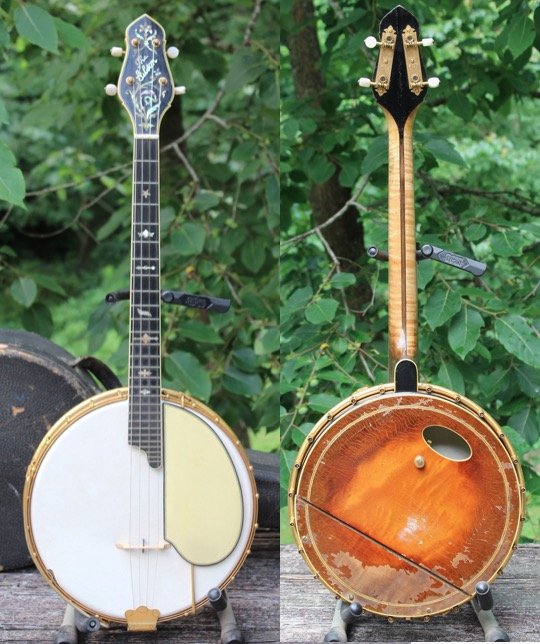“Fern” motif on Gibson TB-5 banjo # 11984-15, expressed with inlaid abalone on the peghead and engraving on the tuner plate.
Gibson TB-5 banjo # 11984-15, gold plated hardware, “Cremona Brown,” “Tone Projector” resonator, ivoroid pickguard and “pearl Pyralin” binding on the rim.
Late June of 1922 finds Lloyd Loar in Kalamazoo, Michigan. In addition to rehearsals with the Gibsonian Concert Orchestra, he is creating a series of articles, “Brass Tack Talks About Banjos,” expounding acoustical theories that influenced new developments at Gibson, including the new Gibson “Mastertone” line of banjos. The importance of establishing Gibson in the booming banjo market may have given rise to at least one aspect of style 5 Master series, as well as the first incorporation of the “fern” inlay pattern. Connections with publishers H. F. Odell and Walter Jacobs, gentlemen cultivated by the Gibson brass at the Guild Convention, allowed this series to appear as articles in their respective journals. The Cadenza ran “Brass Tack Talks About Banjos” in the July, October and November issues; in the The Crescendo different versions appeared July, September, October, November; and in The Music Trades, a condensed version ran on page 153 on December 16, 1922. While these articles were written for banjoists, some of the acoustic principles also applied to the new mandolin family instruments Gibson was on the eve of launching. We are including examples of the articles here. (We have the entire collection on file; if anyone would like copies via email, place note in comment section).
The Crescendo, September, 1922, p. 19.
The Crescendo, October, 1922, p. 19.,
The Crescendo, November, 1922, p. 19.
Longtime Gibson foreman and inventor Victor Kraske had patented his first banjo design in 1902 (in his own name), Loar now undertook a modern approach. (Kraske applied for the patent for his latest banjo design on October 8, 1921; see Episode 9: “What Happens in Vegas” for schematic).
US Patent 1,504,059 filed October 8, 1921. Victor Kraske itemizes some of the key features of his banjo design.
In typical Loar fashion, the new Gibson banjo would embrace a modern approach, with design elements of the new TB-5 based on the acoustic theories discussed in the Crescendo articles.
TB-5 interior. From top left, clockwise: 64-hole brass 1/2 inch tone ring mounted on on 19 ball bearings recessed into a laminated wooden shell (center wooden disc is part of our clamping jig used for installing calfskin heads); tone ring anchored with bent nail; attachment rods; ”tone projector “resonator.
Top: TB-5 in green-lined G & S case; bottom left: “pearl pyralin” binding; bottom right: hand engraved “The Gibson” tailpiece.
The catalog description of Gibson TB-5 banjo in the sales folder circa 1922 presents the term “Mastertone” for the first time. While the earliest TB-5 features many of the Kraske patent design elements, it did not have the “tone projector” resonator or the geared tuners that Loar described in his articles. The resonator featured a “pearl Pyralin” laminate, a dazzling pearlescent celluloid, forerunner of the TB-11 of the 1930s.
Based on examinations of many photographs and corresponding publication dates, it appears that Lloyd Loar and company had the Mastertone banjos in concert the summer of 1922, possibly including an MB-5 mandolin-banjo.
Left to Right: Arthur W. Crookes, CB-4 cello banjo; James H. Johnstone, TB-4 tenor banjo; Francis Havens, CB-4 or 5 (?) cello banjo; Lloyd Loar, MB-5 mandolin banjo; Walter Kaye Bauer, TB-4 (?), tenor banjo. This photo, most likely taken at Johnstone studios the summer of 1922, appeared in the Cadenza, October, 1922; in Gibson banjo sales folder, circa 1922-1923; and on the cover of the later edition of Gibson catalog “N,” November 1923.
It also appears that Leora Haight may have performed on an MB-5 even before the patent was applied for, during the summer tour of the 1921 Gibsonians. At the same time, Louis Bellson, father of the jazz drummer of the same name and brother of Gibsonian Albert Bellson, clearly played a banjo with TB-5 ornamentation with an unusual resonator.
The 1921 Gibsonians with banjos. Left to Right: Evelyn Van Haaften, piano; John H. Moore, guitar banjo; Albert Bellson, tenor banjo; James H. Johnson, tenor banjo; Edna D. Wilcox, mandolin banjo; and Leora Haight, MB-5 mandolin banjo. (Photo The Cadenza, January, 1922)
Louis Bellson with his Gibson TB-5, Gibson banjo sales folder, circa 1922-1923. This model featured the more conventional Pyralin resonator held in place with a center screw.
Walter Kaye Bauer (standing with TB-4) and Arthur William Crookes (seated with CB-4). In addition to featuring this lively duo on banjos in the 1922 tour, Lloyd Loar wrote arrangements dedicated to “Bauer and Crookes.”. (Photo appeared in The Cadenza, November 1921 and March, 1922; it was also used in various Gibson catalogs and advertisements)
Even with banjos, mandolins, rehearsals, Chautauqua tour and writing filling his June days, Lloyd Loar was still able to take out a little time for Mendelssohn on his viola, “in a very polished manner,” on the morning of July 29, 1922.
Battle Creek Enquirer, Battle Creek, Michigan, June 29, 1922.
Our next episode will be posted July 19, 2022, as once again we look back 100 years. After a month on tour, Lloyd Loar and the Gibsonian Concert Orchestra have honed their performance on a dazzling array of new instruments. Check back with us for a complete description of one of the biggest events of the summer as they take the stage at the Cameron, Missouri, Chautauqua with Fisher Shipp and William Jennings Bryan!













